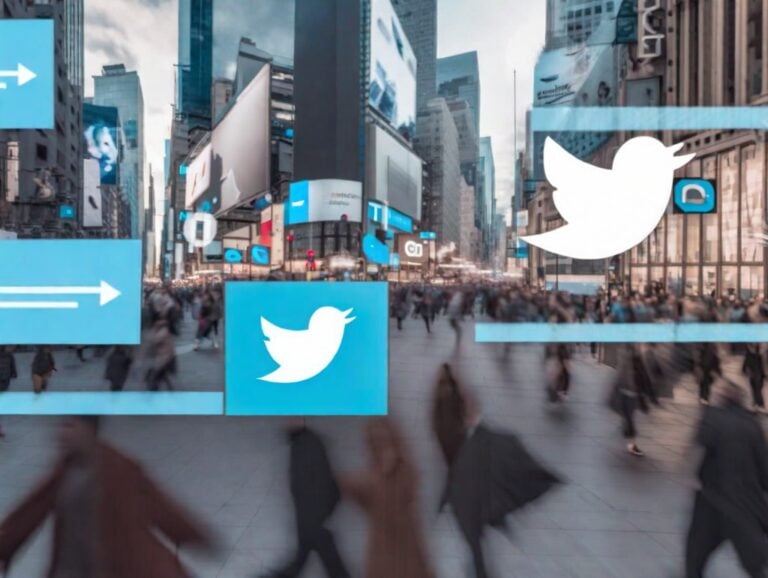One of the biggest challenges on social media is getting your organic content discovered. After all, social networks are more inclined than ever to prioritize paid or boosted content, to the expense of high-quality free posts. While Facebook is the most famous for this, as marketers we need to be mindful of what it takes to get our message to the right people.
Like all other social media platforms, Twitter runs on an algorithm trying to decide what content to serve each user in their newsfeed, and there is no better indicator of content quality in the eyes of any social network than the engagement it receives from your followers and other users. That is why just like any other social network if you are engaged on Twitter for business, engagement matters.
What is Twitter Engagement?

Twitter engagement is a measure of how people interact with your brand or profile on Twitter. It includes Twitter metrics such as:
- Likes: People simply pushing the “like” button to say that a post is good.
- Retweets: When a user shares your Tweet with their audience through the Retweet function.
- Replies: Users answer your question or make comments on Twitter about what you said.
- Mentions: Another Twitter user directs a Tweet in your direction using @username.
- Link clicks: Just what it sounds like: people click through a link to discover your landing page or piece of content.
- Video views: How many times do people watch the videos you post on Twitter? Here, I mean the ones posted directly to the network, rather than the ones linked to and hosted elsewhere.
- Follows: Users opt to have your Tweets added to their feed on a regular basis.
- List additions: If there is a Twitter list in your niche (or for one of the hashtags you target), this metric reflects how often your account gets added to the list. When this happens, you get a lot of extra chances for Twitter engagement because people visit your profile more often.
In other words, anything that shows up in your notifications can be considered an engagement, in addition to if people take action on your post such as watching a video or clicking on a link. This means that your overall Twitter engagement involves a wide variety of actions, all of which can result in sales over time.
Is Twitter Engagement Important?
The whole purpose of social media marketing is to engage social media users, so if you are investing in Twitter marketing, it goes without saying that you want people to engage with your content and profile! This is true no matter what your goal is for each campaign, be it awareness, sales, PR, or anything else.
Taking it one step further, Twitter allows you to tap into its hundreds of millions of users and build brand awareness amongst them. One way to measure that brand awareness is through engagement on your content and profile. In addition, when people click through links there’s often an opportunity to get a sales lead or even make an immediate sale. This means that effective Twitter marketing can have a great ROI, part of which is measured through engagement.
What is the Twitter Engagement Rate?
Not to overcomplicate things here but there are a few ways at looking at what is a Twitter engagement rate depending on your objective that I have seen in my career as a marketer:
- Number of engagements / tweet. In other words, a global measurement of how many times people exhibit any kind of Twitter engagement, per Tweet.
- Number of engagements / tweet impressions. Here, we’re interested in how often people engage after seeing the Tweet. This means we’re mostly interested in the number of eyeballs that engage.
- Number of engagements / followers. How many followers engage with your content, and how many are just lurking?
- Numbers of engagements per tweet / followers. When you send a Tweet, how many followers engage with that specific Tweet. In other words, this metric only counts the engagement from your followers for each Tweet, rather than everyone on Twitter like you see in option 1. This gives an idea of how effective you are at getting engagement from your followers.
Inside Twitter Analytics, they define Twitter engagement rate as a number of engagements/tweet impressions, so that is probably the standard here, but note that there are other ways to think about Twitter engagement rate that you should keep in mind.
What is a Good Twitter Engagement Rate?
While there is no one rule, I would recommend establishing a rate of 1% or higher as a good rate in alignment with other social networks such as Instagram. There are days when my own engagement rate is more than double that, but it is a good rule of thumb to measure yourself against. Remember, some days you’ll do better than others, and for a variety of reasons. The important thing is always to learn from your successes and failures.
Note that an influencer marketing platform did a study and found that a good rate is actually much lower at 0.09% to 0.33%. This would mean that my engagement rate is very high. As always engagement rates vary from account to account and community to community, so your best comparison should be to yourself and your immediate competitors. This way, you can avoid comparing apples to oranges.
What Content-Type Gets the Most Engagement on Twitter?
As you can imagine, there are several factors that can influence how much Twitter engagement a particular Tweet gets. Most of these can be adjusted to improve overall performance over time. And as with many other things social media, analytics are your best friend. Some factors to consider are:
- Timing of the post: what time of day is it for your target audience when the Tweets go out?
- Competition with other tweets at the time: This one’s harder to control, in that you can’t alter when your competitors Tweet. However, you might be able to change your Tweet time to get slightly higher twitter engagement.
- Format of content shared (video vs photo vs link vs status update vs poll). Depending on your niche, you might find that your audience prefers one format over another.
- Relevance of the content to your followers. It almost goes without saying, but if you tweet something that your followers won’t be interested in, or that fewer of them will care about, you’ll likely get lower Twitter engagement for that post. Of course, your audience and brand voice will help determine how far off the beaten path you can go.
- Hashtag usage. The right hashtags can enhance Twitter engagement by getting your Tweet discovered by the right people. Hashtags can also backfire if you pick the wrong ones or select those that have very high competition.
The best way to find out for your own Twitter account is to experiment over the course of 1 to 3 months sharing multiple combinations of tweets that fall under the above factors so that you can find out the individual answer for your business based on doing this type of Twitter audit.
How to Increase Your Twitter Engagement
Now that you’re sold on the importance of all of this, here is my advice on how to increase your Twitter engagement based on my 13+ years of being active there. Some of these approaches will work better for certain people, and certain accounts, than others. However, each of my tips remains a reasonably good guide to boosting Twitter engagement.
1. Timing, Timing, Timing!
This goes without saying, but you should tweet when you think most of your followers are online. Unfortunately, this isn’t always easy, especially when your audience lives across several time zones. However, I’ve found that the best thing to do is to experiment with tweeting at different hour intervals on a regular basis and examine your Twitter analytics to get a feel as to when the best time to post for your audience is. In addition, you can consider sending out Tweets throughout the day to catch more people online.
Further Reading: The 22 Best Twitter Schedulers to Ramp Up Your Twitter Marketing
2. Make Sure Your Content Is Actually Relevant
Next, you want to ensure that your content is something that people want to read. To do this, experiment with different content categories and then look at your Twitter Analytics to better understand what your followers are engaging with and publish more of it. While you might not want to use the same content all the time, knowing what mix works well while keeping everyone interested is the best policy.
Further Reading: Why Evergreen Tweets are Critical to Twitter Marketing Success
3. Use More (and More!) Visual Content

Like any other social media platform, photos and videos tend to do well and/or get more visibility in the newsfeed. Especially on Twitter, the sea of words can get blurry as people scroll through their feed. In the meantime, viewers are much less apt to contribute to Twitter engagement.
Visual posts are also interactive and take up more space in the timeline, beckoning you to engage with them. If nothing else, viewers are more likely to stop and enjoy a picture or video. In turn, this helps reinforce your brand message. The fact that this works is borne out by studies. Twitter themselves analyzed tweets and determined that photos get 35% more engagement than non-visual content.
Let’s look at this another way. Wonder why you see so many GIFs on Twitter? Because they work! A study by Twitter found that GIFs received 55% more engagement than regular, “word-based” Tweets. Want even better results? Tweets with videos garner 10x the engagement! In other words, people love visual Tweets in general, and videos in particular. How’s that for a formerly boring-looking social network?
Is Your LinkedIn Not Delivering Results?
Just released: my new book to help professionals, entrepreneurs, and business owners maximize LinkedIn for real growth.
With years of LinkedIn expertise, Maximizing LinkedIn for Business Growth offers actionable steps to build your brand, expand your network, and drive results.
Start leveraging LinkedIn like never before—grab your copy now! Click the cover or button below to buy on Amazon.
Further Reading: How to Tweet a Video the Right Way on Twitter
4. Proactively Engage with Others
You follow people for a reason, right? Engaging with their content by Retweeting or commenting on it will often lead to them checking out and engaging with your content. After all, curiosity will draw them in if nothing else. In addition, should the other user respond to your engagement, chances are that the algorithm will see this as a signal and might allow your future tweets to be more discoverable in their feed. Over time, this can build Twitter engagement even further.
Keep in mind, being proactive also means to be proactively following and engaging with relevant people outside of your followers as well. This helps you discover new people, but it also introduces you to others who haven’t heard from you yet. Start with followers of your followers, or look at who reacts to other people’s Tweets with relevant hashtags. Remember, hashtags are very useful.
5. Reactively Respond
It goes without saying that engagement builds engagement so make sure you respond when others engage with you to keep the engagement – and conversation – going! Or, viewed another way, people like it when you reciprocate their Twitter engagement. By responding further, you’ll show reciprocity that helps build relationships and, in turn, invites other people to check out your content because someone they follow is engaging with you.
6. Share Your Source
Giving other people credit where it is due always pays dividends. I go out of my way to try to share the source of my tweets if I share them from another source. This gives your tweet more credibility, shows respect to the content creator, and actually gives you a chance to garner engagement from someone who just might be an influencer.
This is why I always say, when done right, content curation in this manner is the best way to get started with influencer marketing. Influencers gain that position on Twitter because they are thought leaders on some level. And in the process of earning that designation, they need to interact with their followers. If you attract their interest, then that Twitter engagement can bring you to the attention of the influencer’s followers.
7. Use Hashtags
While hashtags are not as critical as Instagram, even Twitter has said using hashtags will increase engagement by 16% on average. One reason for this is that the hashtags will sort your tweets and make them easier to find by the right people. Especially if you look at engagement per Tweet, the results can add up fast.
Other companies on the social media scene have found more impressive numbers. For instance, Hubspot found that using hashtags correlated with a whopping 1,065% increase in engagement! In addition, a different survey found that tweets with hashtags are 33% more likely to be retweeted. Considering that a Retweet exposes your content to wider audiences, this is an especially valuable type of Twitter engagement.
8. Participate in Trending Conversations
This is an often-overlooked way to try and boost engagement. However, Twitter shows trending hashtags for a reason. Leverage them and join the conversation when it makes sense to do so. As a general rule, it makes sense to join the discussion when the trending topic is relevant to your niche or touches on an issue your company is passionate about.
9. Launch a Poll
Finally, you might try to launch a pol. While not as viral as polls on LinkedIn, chances are that Twitter polls can gain more engagement for you than an average tweet, but like with everything else, your mileage might vary. With that said, polls are often useful if your company is looking to make some changes in their product line or wants feedback for some other reason. In a few instances, if brand-appropriate you can try a “just for fun” poll. Some people love to feel that they have a voice.
Further Reading: 11 Ways to Use Twitter Polls for Marketing (with Examples)
Boosting your Twitter engagement may feel like a daunting task. After all, Twitter isn’t as “cool” as it once was. Nonetheless, Twitter remains a powerful force in some sectors, so it’s still a place to see and be seen. With careful planning, and the tips I’ve given in the article, most brands and individuals can boost their engagement rate.
Further Reading: The 21 Best Twitter Tools for Marketing
Hero photo by Edgar Moran on Unsplash












